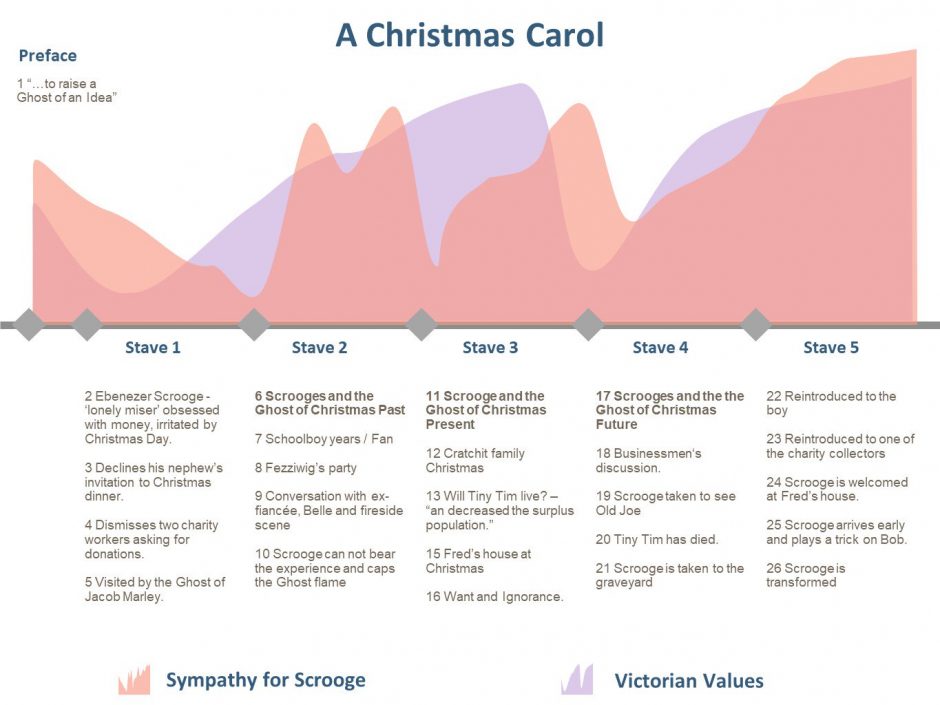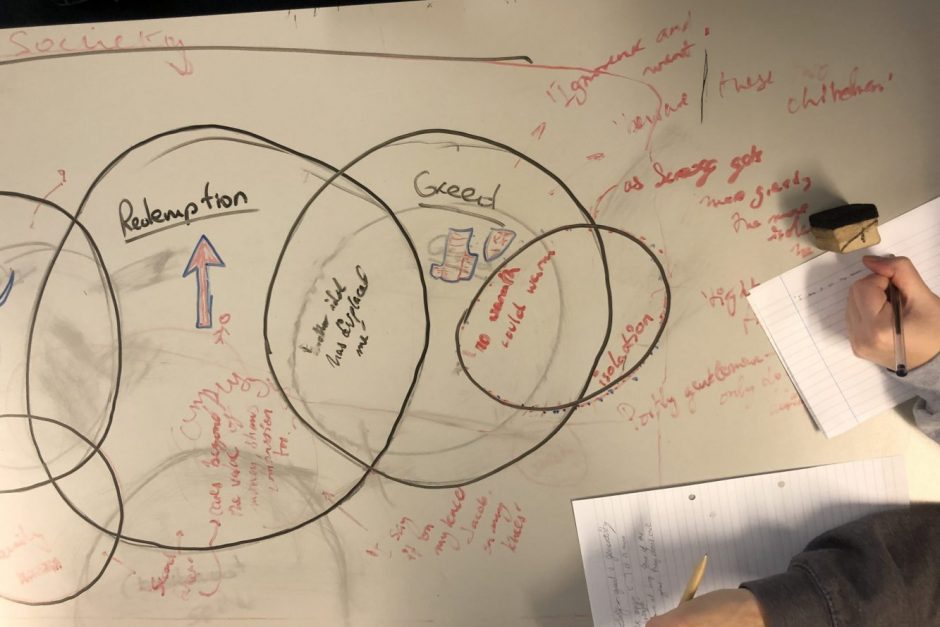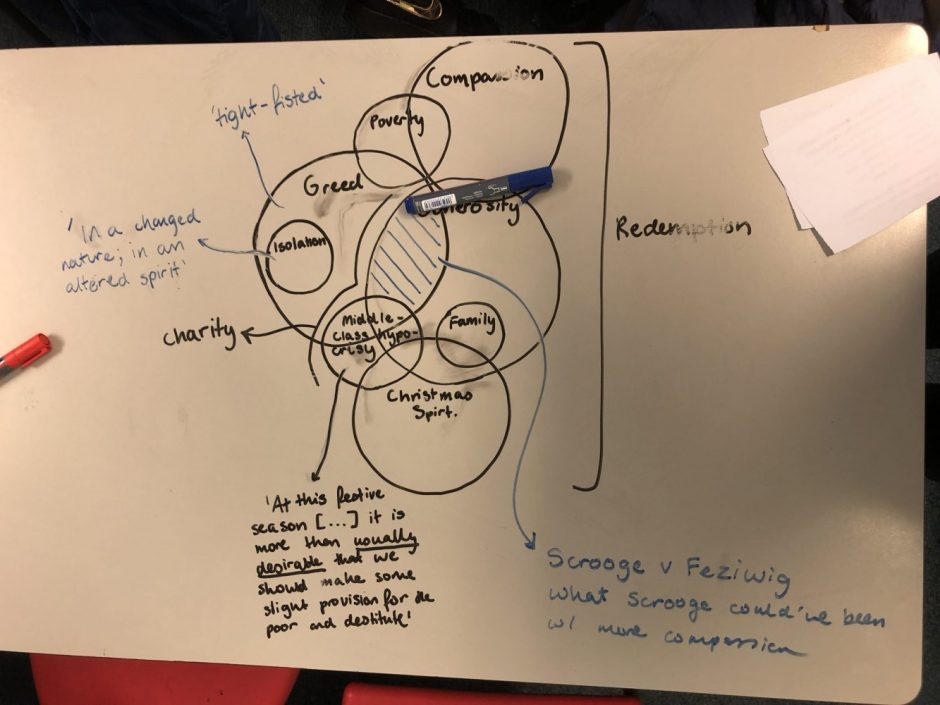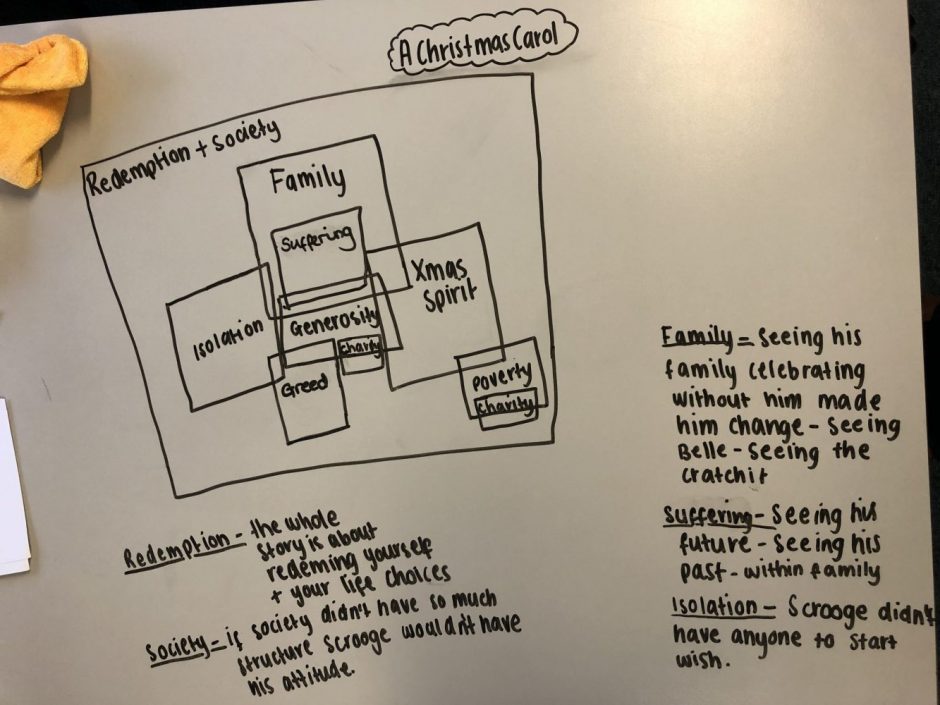Making the abstract, concrete with a thinking routine.
Since teaching A Christmas Carol, I have been thinking about how to teach themes and share / track the evolution of themes within a text. How to make a relatively abstract concept,the interplay and undulation of themes, more concrete (at least accessible).
Having previously presented or charted the themes of A Christmas Carol, I was still looking for a way for students to physically and tangibly interact with the themes. Ideally I was looking for hands-on learning. In the same that maths blocks make numbers concrete.

With hindsight – I explicitly taught the vocabulary of themes (and motif and symbol) and “coded” three Othello themes: love, betrayal and honour. I taught this lesson right from the outset. (We also covered the contextual influences of the Elizabethan society and specifically those relevant to Othello – this will be important later). In the scheme of learning, I marked time to review themes and sought connections in the assessments or writing bursts, motivating our investment. (Little did I know at this point how truly brilliant Othello’s characters would be for this type of chronological investigation).
Themes of Othello
- Love – an intense feeling of deep affection
- Betrayal – the action of betraying one’s country, a group, or a person; treachery.
- Honour – high respect; great esteem.
- Love – a powerful force in the lives of Desdemona and Othello, whose secret marriage is the spark that ignites the plot.
- Betrayal – Trust and betrayal are features of nearly every relationship in Othello.
- Honour – Honour is a driving force in the lives of the Elizabethan men.
Elizabethan themes – Cosmopolitan and Patriarchal
Second, these themes are presented as ‘attack words’ on banner at the bottom of slides during lessons. Where possible, themes are ‘noticed’ and reinforced. We frequently use this vocabulary.
From teaching ‘A Christmas Carol,’ the visual representation of themes as a plait, weaving through the narrative, had now trumped the ‘layered cake,’ image. I think that sharing coherent messages is important – within and across classrooms. (Onions are being reserved for layers of analysis). With the students having been taught themes previously, building on this schema definitely accelerated the students assimilation of love, honour and betrayal in this unit.
Thinking hard about themes, and drawing on ‘Culture of thinking,’ I wanted to build an activity or routine where the students had to think hard about each theme, the interaction between them, their rise and fall to be able to see the plait Shakespeare was weaving. To be conscious of them. Could I have asked for a better text than Othello! With this in mind, I trialled “Thinking Circles.”
Thinking Circles went through iterations, a Y8 top set, two Y9 middle sets and a Y11 GCSE with a colleague. What I am sharing is an unpolished final draft with two entry points, pending the attainment profile of the class. It may not be physically tangible, it does enable the learner to interact. Here is what I am learning…
Low entry point
Introducing Thinking Circles. In this case, three key themes. In the “edit mode” in Powerpoint – demonstrate that the “significance” of the theme can be signalled by increasing / decreasing the circle size. The relationship between the themes signalled by their placement (Detached / Intersection / Within).

I then share my reasoning – size / placement – in a fictitious scenario in the play. LIVE.

Mid entry point
Two rings – Elizabethan influences. Themes, motifs and symbols are then added to the base layer. Same rules apply to rings as circles – labels have been moved to the top.

To set the parameters of the students thinking, I shared a brief outline of what the students were expected to consider, the story so far. Circles not yet in play were moved to the side.

In the live demo the text is removed. One group worked live on the PC, with students working in pairs in their exercise books. Their conversations were fascinating – thinking and negotiation was audible.


I plan to revisit Thinking Circles at the end of each Act or at suitable opportunities in the play to show the development of the narrative. I also know, it will be a lot more about the thinking and less about the explanation each subsequent time we revisit “Thinking Circles.”
Rather than using a IWB or the PC or paper… how about using the desk as my colleague did?



I happened to be at his door returning borrowed glue sticks as the students were leaving. Feedback from the students was genuinely very positive. My colleague had taken these photos and also gather some exit ticket / feedback statements. (I asked if I could share them here).
Four weeks later
The emergence of thematic references in lessons from students is promising. Students are using the vocabulary of themes a lot more – to be expected. Student language however is also suggesting they are thinking about themes in a more concrete way; “honour is shrinking,” or “betrayal is growing and eating up honour” or “love is now almost detached from honour and betrayal now.”
Time has been tight. We have not yet reviewed / revisited our diagrams but we will be – at the end of Act 3. Given the seismic shift in the themes of Othello.
Interestingly, “Thinking Circles” has seeped into neighbouring classrooms – which makes me think there is something to routine. Theme references play a more significant role in student’s verbal and written responses – which would suggest students are thinking at a much deeper and sophisticated level?
Pending time… I will following up this post following the conclusion of Act 3.3 and at the end of the play.
Ten weeks later
This week we revisited theme modelling for the third and final occasion of the Shakespeare units in Y8 and Y9. Year 8 in concluding Romeo and Juliet Act 4 with a focus on Juliet, Year 9 in concluding Act 4 with a focus on Othello. Simply presenting the previous models was stimulus enough for the third, which was first modelled live on screen by a lead learner, then modelled in pairs. Yes, one of two pairs needed reminding to focus on the task, however I was really proud the pupils and the ‘thinking’ that went into the modelling conversations.
I was even more impressed by deep and analytical class debate / justification of the exemplar displayed on the board, that followed.



Pingback: The character of – Edventures